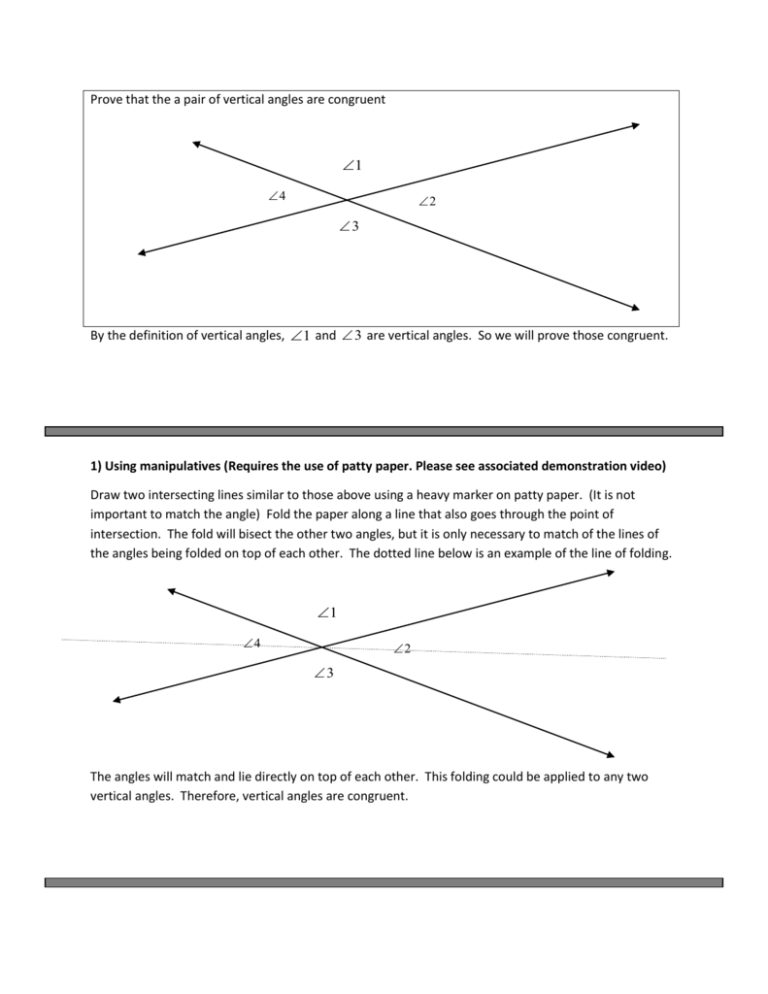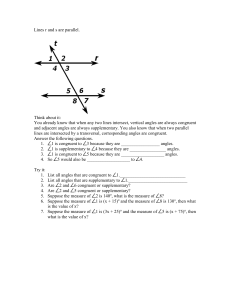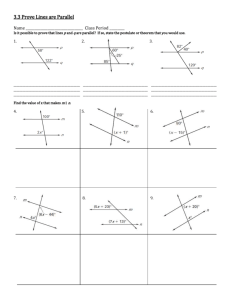Vertical Angles Proof Samples
advertisement

Prove that the a pair of vertical angles are congruent 1 4 2 3 By the definition of vertical angles, 1 and 3 are vertical angles. So we will prove those congruent. 1) Using manipulatives (Requires the use of patty paper. Please see associated demonstration video) Draw two intersecting lines similar to those above using a heavy marker on patty paper. (It is not important to match the angle) Fold the paper along a line that also goes through the point of intersection. The fold will bisect the other two angles, but it is only necessary to match of the lines of the angles being folded on top of each other. The dotted line below is an example of the line of folding. 1 4 2 3 The angles will match and lie directly on top of each other. This folding could be applied to any two vertical angles. Therefore, vertical angles are congruent. 2) Paragraph Form: 1 and 3 are both create a linear pair when combined with 2 . This means that if the measurement of 2 is added to 1 or the measurement of 2 is added to the measurement of 3 , the total would be 1800.. This would imply that the measure of both 1 and 3 would be the same amount remaining to be added to 2 . Therefore the angles would be congruent. This argument could be applied to any pair of vertical angles. 3) Two column proof Statement 1. 1 and 3 are vertical angles 1 and 2 are form a linear pair 3 and 2 are form a linear pair 2. 1 and 2 are supplementary angles 3 and 2 are supplementary angles 2. m 1 + m 2 = 180o m 3 + m 2 = 1800 3. m 1 + m 2 = m 3 + m 2 4. m 1 = m 3 5. 1 ≅ 3 Reason 1. Given in figure 2. Definition of a linear pair 2. Definition of a supplementary angles 3. Substitution 4. Subtraction property of equality 5. Definition of congruence 4) Proof Blocks 1 and 3 are vertical angles 1 and 2 are form a linear pair 3 and 2 are form a linear pair 1 and 2 are supplementary angles 3 and 2 are supplementary angles m 1 + m 2 = 180o m 3 + m 2 = 1800 m 1 + m 2 = m 3 + m 2 m 1 = m 3 1 ≅ 3 All ProofBlock resources have been adapted with permission from Jennifer and Nathaniel Dirksen, creators of ProofBlocks. To access additional ProofBlock resources, visit http://www.proofblocks.com







![7th Grade [Pre-Algebra] Math Vocabulary](http://s3.studylib.net/store/data/006617991_1-76ce0e26cff8b794b821343c050f71cb-300x300.png)